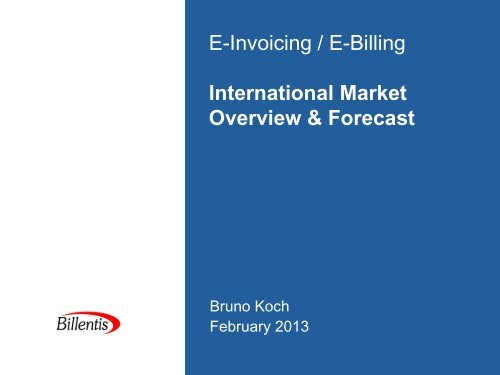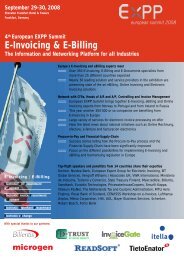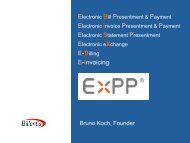E-Invoicing / E-Billing International Market Overview ... - Billentis
E-Invoicing / E-Billing International Market Overview ... - Billentis
E-Invoicing / E-Billing International Market Overview ... - Billentis
Create successful ePaper yourself
Turn your PDF publications into a flip-book with our unique Google optimized e-Paper software.
E-<strong>Invoicing</strong> / E-<strong>Billing</strong><strong>International</strong> <strong>Market</strong><strong>Overview</strong> & ForecastBruno KochFebruary 2013
Global overview11.02.2013page 2
<strong>International</strong> E-<strong>Invoicing</strong> <strong>Market</strong> 2013Leaders Average Developing Laggards11/02/2013© Bruno Koch, <strong>Billentis</strong> - Reproduction is authorised provided the source is acknowledged.page 3
Development of E-<strong>Invoicing</strong> <strong>Market</strong>PenetrationRecipientsegmentConsumerBusiness& GovernmentAnnual bill &invoice volumeestimated to be atleastEstimatedelectronicproportion oftotal volume in2013Estimated annualvolume increasein electronicbills/invoicesWorld Europe World Europe World Europe200billion150billion17 billion13%20%>5%20%16 billion 20% 29%11.02.2013© Bruno Koch, <strong>Billentis</strong> - Reproduction is authorised provided the source is acknowledged.page 4
North America• Payment, Trade Finance and Procurement as main drivers• Preference for optimization of internal operations (AR and APmanagement); E-<strong>Invoicing</strong> just one feature of P2P automation• Increasing focus on collaboration with trading partners• Direct exchange of E-Invoices among trading partners dominates;compared to Europe and LATAM, 3rd party operators not yet verynumerous and powerful• US Treasury Bureaus were mandated to implement InternetPayment Platform (IPP) by end of 2012; by 2013, Treasury willrequire that its commercial vendors submit their invoices using IPP• The market for E-<strong>Invoicing</strong> is opening up. Currently at $280million, PayStream Advisors predicts demand is growing at acompound average annual growth rate of 13 percent.11/02/2013© Bruno Koch, <strong>Billentis</strong> - Reproduction is authorised provided the source is acknowledged. page 5
Latin America• Very strict legislation• E-<strong>Invoicing</strong> pushed by public sector• Real-time audit or invoice data mining by tax authorities with theaim of combating tax evasion• Obligations for E-<strong>Invoicing</strong> announced/planned in Chile, CostaRica, Ecuador, Guatemala, Uruguay (local stakeholders expect ajump to 70% E-<strong>Invoicing</strong> market penetration in the country by2015)• Brazil, Mexico and Chile as market leaders11/02/2013© Bruno Koch, <strong>Billentis</strong> - Reproduction is authorised provided the source is acknowledged. page 6
Asia & Pacific• First steps with B2C E-<strong>Billing</strong>; B2B legislation missing in manycountries; sometimes, EDI invoices & paper originals• Many advanced countries are more likely to adopt the (tax)control focussed LATAM model than the liberal European model• Russian legislation now supports E-<strong>Invoicing</strong>; increasing activitiesin this large market• Some other countries mandate the market participants toexchange invoices in electronic format, e.g. Kazakhstan, Nepal,Singapore, critical industries in Turkey, …• Some countries are in the process of closing the loop betweentills at points of sale – tax authorities – and clients. This happenseither with the help of fiscal printers or electronic receipts(similarities with E-<strong>Billing</strong>)• Several advanced initiatives of federal administrations in thePacific Region, including eProcurement11/02/2013© Bruno Koch, <strong>Billentis</strong> - Reproduction is authorised provided the source is acknowledged. page 7
European <strong>Market</strong>11.02.2013page 8
<strong>Market</strong> Penetration 2013(Electronic share of total invoice/bill volume)B2B/B2G/G2BB2C>40% 15-40%
Mixed European market development (1)• Segments with (relative) decreasing growth rates due to some saturation in a few Nordic countries and high volumeindustries (e.g. Retail, Telecom, Utilities, Healthcare inSwitzerland) postponed projects due to uncertainty about the legalchanges when published not earlier than Q4 2012.• Segments with (relative) increasing growth rates due to the special effect caused by the new legislation in EUcountries implemented it in 2010-2011; a proportion (around20%) of unsigned PDF not considered in the past becomespart of the statistic as they are now tax compliant; theremaining 80% of the PDF invoices are still not considered asthe survey shows that they are printed and the electronicorigin is not archived11/02/2013© Bruno Koch, <strong>Billentis</strong> - Reproduction is authorised provided the source is acknowledged. page 10
Mixed European market development (2)• Segments with (relative) increasing growth rates due to higher publicity and increasing demand public sector initiatives• Decreasing (relative) growth rates for E-<strong>Invoicing</strong> networks due to substitution by direct model or SaaS larger networks including some operators with a focus onslower growing industries (Retail, Healthcare) basis effect for some larger operators. Maintainingexponential growth is a challenge.11/02/2013© Bruno Koch, <strong>Billentis</strong> - Reproduction is authorised provided the source is acknowledged. page 11
Development of European <strong>Market</strong> PenetrationElectronic share 2008 2009 2010 2011 2012 (E) 2013 (E)B2C 4% 5% 7% 9% 11% 13%B2B/B2G/G2B 6% 8% 10% 13% 16% 20%Weighted average 5% 7% 9% 11% 14% 18%11.02.2013© Bruno Koch, <strong>Billentis</strong> - Reproduction is authorised provided the source is acknowledged.page 12
Channels Used for Electronic InvoicesB2B/B2G/G2B volumeThe strong increase in direct volume is mainly a statistical effect. Due to the new legislation inEU countries, a portion of the unsigned PDF invoices belongs now to the “tax compliant”invoices and are therefore considered in these statistics.11.02.2013© Bruno Koch, <strong>Billentis</strong> - Reproduction is authorised provided the source is acknowledged.page 13
Channels Used for Electronic BillsB2C volumeA very large German Telco operator loses steam and the proportion of its E-<strong>Invoicing</strong> users increases justmodestly. Due to its size (15+ million e-bill subscribers), it has an impact on the European figures.11.02.2013© Bruno Koch, <strong>Billentis</strong> - Reproduction is authorised provided the source is acknowledged.page 14
E-<strong>Invoicing</strong> networkoperators in Europe11/02/2013page 15
Expected Trends 2013/2014• Provider offerings Price erosion is likely to accelerate, especially on the supplierside and for the classic transaction business with little addedvalue Increasing importance of further added valueso Trade Financeo Broad market coverage (directly or via partners) Interoperability and open platformso Support for processes and messages exchanged beforean invoice appears• Increase in direct exchange of (unsigned) PDFs bypassingoperators; secure ePost / digital mail services unlikely to occupythis field• New operators in countries with powerful public sector projects• Downturn or takeover of providers not yet profitable, withoutsubstantial market share or with an inflexible solution architecture11/02/2013page 16
Number of OperatorsE-<strong>Invoicing</strong> network operators in Europe60050040030020010002008 2009 2010 2011 2012 2013 2014 2015 201611.02.2013© Bruno Koch, <strong>Billentis</strong> - Reproduction is authorised provided the source is acknowledged. page 17
Number of operatorsChanges in the service provider landscape100806040200-20-402008 2009 2010 2011 2012 2013(Est.)New marketentrantsOperatorsturned downAcquired, justnew ownerMerged &integrated11.02.2013© Bruno Koch, <strong>Billentis</strong> - Reproduction is authorised provided the source is acknowledged. page 18
<strong>Market</strong> size and expected growthThe service provider community might generate in Europe in 2013 atransaction based E-<strong>Invoicing</strong>/E-<strong>Billing</strong> turnover of about 1.7 billionEuro. The turnover* is estimated to grow annually by 17-15% duringthe next 3 years.*) Besides this transaction based turnover, additional business is generated with the application and integration business.The valuation of that part is subject of future investigations.11/02/2013© Bruno Koch, <strong>Billentis</strong> - Reproduction is authorised provided the source is acknowledged. page 19
Turnover / E-Invoice (EUR)E-<strong>Invoicing</strong> Network Operator Turnover (1)Evolution of the Metric Turnover/E-Invoice (B2B/B2G/G2B)2Phase 1 Phase 2 Phase 3 (E) Phase 4 (E)12005 2009 2013 2017 202011.02.2013© Bruno Koch, <strong>Billentis</strong> - Reproduction is authorised provided the source is acknowledged. page 20
E-<strong>Invoicing</strong> Network Operator Turnover (2)Assumptions, considered providers and calculation base• Considered are Service Providers acting in Europe and including allcategories of operators (EDI Clearing Centres, focussed E-<strong>Invoicing</strong>operators, others like electronic marketplaces); depending on the degreeof added value and international coverage, the services are notnecessarily directly comparable, but all considered operators have incommon that they process and exchange tax compliant E-Invoices.• The author developed concrete benchmarks in 2004 and 2009 based onthe typical size/volume of senders and recipients at that time andinvestigated the situation again in January 2013.• Considered sources are the ratio of the turnover and the processedvolume of some larger operators, inside information on consultingprojects and several published price lists. In the latter case, thecalculation formula include the depreciation (within 2 years) of the setupfee if applicable, the time based fee (annual or monthly fee) and thetransaction fee.11.02.2013© Bruno Koch, <strong>Billentis</strong> - Reproduction is authorised provided the source is acknowledged. page 21
E-<strong>Invoicing</strong> Network Operator Turnover (3)Phase 1 (2004-2008)• From 2004, legislation adopted by EU members supported E-<strong>Invoicing</strong>.• Pioneer operators developed the E-<strong>Invoicing</strong> <strong>Market</strong>. Their costsas market makers were tremendous.• Large buying organizations showed interest in E-<strong>Invoicing</strong>. Due totheir multinational trading network, they had very demanding legalrequirements. However, they recognized their own cost savings asrecipients of electronic invoices and accepted a fee for exploitingthis saving potential.• Their suppliers, as invoice issuers, also saw the saving potentialand accepted a fee for the services of an E-<strong>Invoicing</strong> network.• There was not much competition between E-<strong>Invoicing</strong> networksaimed at addressing this demand by multinationals.Issuers and recipients can save costs with E-<strong>Invoicing</strong>. In Phase 1, bothparties benefitting of it were willing to pay a reasonable price.11.02.2013© Bruno Koch, <strong>Billentis</strong> - Reproduction is authorised provided the source is acknowledged. page 22
E-<strong>Invoicing</strong> Network Operator Turnover (4)Phase 2 (2009-2012)• The growth from 340 to 540 E-<strong>Invoicing</strong> network operatorsresulted in strong competition, price pressure and innovation.• Large users increasingly benefited from volume rebates.• Small suppliers typically had the opportunity to key-in a limitednumber of invoices for low or no transaction cost on web portals ofE-<strong>Invoicing</strong> networks.2011: The processed E-<strong>Invoicing</strong> volume via service providersincreased almost 30%, but the turnover “just” 21%. 7% less Turnover/E-Invoice compared to previous year11.02.2013© Bruno Koch, <strong>Billentis</strong> - Reproduction is authorised provided the source is acknowledged. page 23
E-<strong>Invoicing</strong> Network Operator Turnover (5)Phase 3 cont….• The public administration becomes a user, thereby affecting the vast majority of enterprises in each Europeancountry. increasing the number of users as well as the processedvolume significantly.• Most countries declaring some level of obligation to E-<strong>Invoicing</strong>might see additional service providers trying to play a rolebetween the suppliers and the public administration. This isdespite the fact that federal administrations typically do not intendpaying a fee as an E-Invoice recipient but just as an issuer.• Increasingly, service providers rely on just the fees of senders ofelectronic invoices and other business documents.• Bi-directional exchange of business documents becomes morepopular; the income erosion per E-Invoice might be at leastpartially compensated through additional business messages andother added-values.11.02.2013© Bruno Koch, <strong>Billentis</strong> - Reproduction is authorised provided the source is acknowledged. page 24
E-<strong>Invoicing</strong> Network Operator Turnover (6)Phase 3 (2013-2016)• The price erosion might be driven by further parameters Discount providers gain traction. The new legislation in EU countries gives a boost towardsdirect exchange of PDF invoices, bypassing the serviceproviders.• Service provider contracts with the first generation of large E-<strong>Invoicing</strong> users might expire, resulting in tough price negotiationsfor renewal.• Standardization of E-<strong>Invoicing</strong> makes changes from one serviceprovider to the next easier.The Turnover/E-Invoice is estimated to erode by 10% p.a.However, new related business opportunities might appear and wehave not to be concerned regarding the survival capability of agileproviders.11.02.2013© Bruno Koch, <strong>Billentis</strong> - Reproduction is authorised provided the source is acknowledged. page 25
E-<strong>Invoicing</strong> Network Operator Turnover (7)Phase 4 (2017-2020)• Mass market• E-<strong>Invoicing</strong> as a commodity business• Service providers might offer the services on average for the price“internal costs + small margin” (e.g. EUR 0.15 ± 0.05) and use itas a base for other added-values.• Why did I not explicitly mention the operators offering the services“for free”? Because the previous slides consider the “wholeoperator community” and the figures build averages.A limited number of operators are expected to be competitive due toeconomies of scale. Others might differentiate themselves byoffering added value along the electronic supply chain or byfocussing on interesting market niches.11.02.2013© Bruno Koch, <strong>Billentis</strong> - Reproduction is authorised provided the source is acknowledged. page 26
Analysis of financial figuresAnalysis:• Considers justproviders withE-<strong>Invoicing</strong> as asignificant part of theirbusiness (at least 1/3of turnover)• Hard facts & figuresfrom 150 financialstatements / annualreports• Own estimates for all550 operators includingyounger marketentrants.It seems that the improved financial flexibility is immediately invested togain additional market share (marketing & sales, price reductions, …)11.02.2013© Bruno Koch, <strong>Billentis</strong> - Reproduction is authorised provided the source is acknowledged. page 27
In-depth market informationPlease find further details in the <strong>Market</strong> Report“E-<strong>Invoicing</strong> / E-<strong>Billing</strong> 2013 – Catalyst for AR/AP automation”Report issued in April 2013.For further information, please visitwww.billentis.com11.02.2013© Bruno Koch, <strong>Billentis</strong> - Reproduction is authorised provided the source is acknowledged. page 28
Definitions &Methodology11.02.2013page 29
Not considered in my statisticsDefinitions as used in my statisticsE-InvoicesElectronic, nokTransported and archived fully electronically from endto-endin a tax compliant manner; 2011: 10%+ in EuropeFully electronic, but not tax compliant due to lack ofintegrity, authenticity and legibility; ≈ same volume astax compliant invoicesSemi-electronicElectronic invoices are supported by paper summaryinvoices, scanned or printed/archived by recipients;≈ same volume as tax compliant invoicesTransportedand archived aspaper onlyMajor bulk of paper invoices11.02.2013© Bruno Koch, <strong>Billentis</strong> - Reproduction is authorised provided the source is acknowledged. page 30
Methodology• Screening and interpreting 650+ key sources, including: User surveys in countries (AT, ES, FR, PT etc.) and industries(e.g. banking associations, GS1, santésuisse, …) Figures from large invoice issuers & recipients (e.g. DeutscheTelecom with around 600 million issued invoices p.a., publicsector in several countries representing 10%+ of invoicevolume in each country) Figures of leading service providers Consolidated figures of domestic E-<strong>Invoicing</strong> associations• In total, results of surveys with 15,000+ enterprises and10,000 consumers are considered in these statistics andforecasts11.02.2013© Bruno Koch, <strong>Billentis</strong> - Reproduction is authorised provided the source is acknowledged. page 31









